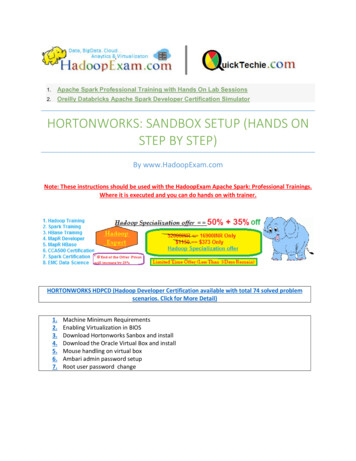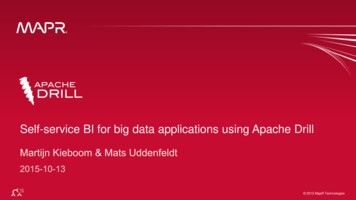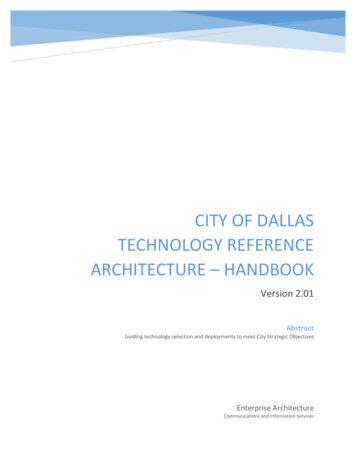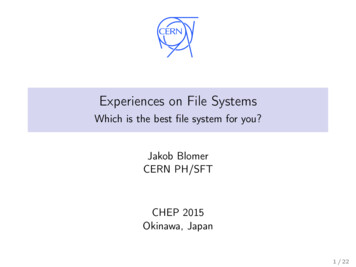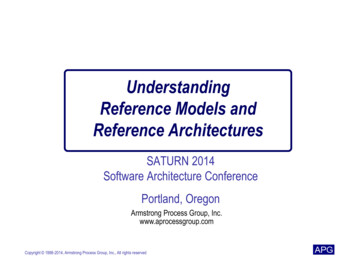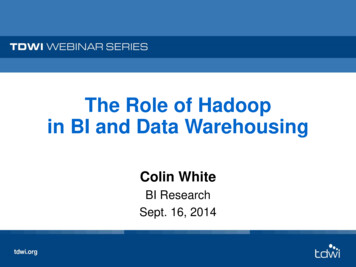
Transcription
MapR Data Platform Reference Architecture forOracle Cloud Infrastructure DeploymentsORACLE WHITE PAPER OCTOBER 2018
DisclaimerThe following is intended to outline our general product direction. It is intended for informationpurposes only, and may not be incorporated into any contract. It is not a commitment to deliver anymaterial, code, or functionality, and should not be relied upon in making purchasing decisions. Thedevelopment, release, and timing of any features or functionality described for Oracle’s productsremains at the sole discretion of Oracle.Revision HistoryThe following revisions have been made to this white paper since its initial publication:DateRevisionOctober 19, 2018Initial publicationYou can find the most recent versions of the Oracle Cloud Infrastructure white papers s.2 MAPR DATA PLATFORM REFERENCE ARCHITECTURE FOR ORACLE CLOUD INFRASTRUCTURE DEPLOYMENTS
Table of ContentsOverview4Terminology4Infrastructure Guidance4Compute Considerations4Storage Considerations5Network Considerations6MapR on Oracle Cloud Infrastructure Deployment Recommendations7Cluster Architecture7Network Architecture8Automated Cluster Deployment with Terraform and the Oracle Cloud Infrastructure Provider11Installation Model Overview11Single Availability Domain Deployment Model12Terraform Template13MapR Configuration 14MapR on Oracle Cloud Infrastructure14Appendix15Related Links15Terminology Reference153 MAPR DATA PLATFORM REFERENCE ARCHITECTURE FOR ORACLE CLOUD INFRASTRUCTURE DEPLOYMENTS
OverviewThis document details best practices for running MapR Data Platform (MapR) on Oracle CloudInfrastructure. Although individual use cases and requirements might vary and require differentapproaches, the practices described here represent the ideal configuration for both performanceand security for implementation on Oracle Cloud Infrastructure. Topics covered in this documentinclude installation automation, automated configuration and tuning, and best practices fordeployment and topology to support security and high availability.Customers of MapR and Oracle Cloud Infrastructure can now run MapR deployments in the cloud,leveraging the power of Oracle Cloud Infrastructure bare metal and virtual machine instances todrive flexible, easily scalable, and performant MapR clusters in an automated fashion by usingTerraform.This cloud reference architecture represents best practices for sizing and deployment on OracleCloud Infrastructure. See the Appendix for links to the latest MapR documentation assupplemental reference material.TerminologyIf you are unfamiliar with Oracle Cloud Infrastructure, see the reference section in the Appendix fordefinitions of the basic components.Infrastructure GuidanceAll MapR deployments on Oracle Cloud Infrastructure leverage either bare metal or virtualmachine instances for cost-efficient, highly performant, fast cloud infrastructure. The choice ofwhich instances to use is up to you and is configurable as part of the deployment, but this sectionoutlines some best practices to follow.Terraform templates available on GitHub are preconfigured with the recommended instance types.Changing the instance types as part of the deployment might result in an unsupported clusterconfiguration with less than the required memory and disk capacity, so be aware of this beforemaking changes. The preconfigured instance types comply with MapR’s requirements.Compute ConsiderationsWhen you are choosing the architecture for your MapR deployment on Oracle CloudInfrastructure, there are many options to consider. This section provides some guidelines aboutthe instances that MapR supports.4 MAPR DATA PLATFORM REFERENCE ARCHITECTURE FOR ORACLE CLOUD INFRASTRUCTURE DEPLOYMENTS
Bare Metal ComputeBare metal DenseIO instances on Oracle Cloud Infrastructure provide fast, reliable compute powerand NVME-based local storage. Two profiles are supported for bare metal instances runningMapR as data nodes; these differ based on compute, memory, and storage density. BM.DenseIO1.36This instance provides 36 OCPUs (72 vCores), 512 GB of memory, and 28.8 TB localNVMe storage. Additional block storage can be attached, up to 1 PB per host. BM.DenseIO2.52This instance provides 52 OCPUs (104 vCores), 768 GB of memory, and 51.2 TB localNVMe storage. Additional block storage can be attached, up to 1 PB per host.For more information about these compute profiles, including performance-related metrics, see theHigh Performance X7 Compute Service Review and Analysis blog post.Virtual Machine ComputeMapR can be deployed on VMs using block storage for MapR-FS. When you use VMs, be sure toconsider IOPS and bandwidth constraints when configuring your deployment.VM.Standard and BM.Standard InstancesIt is possible to configure MapR deployment to leverage BM.Standard and VM.Standard instancesas data nodes. Before you assign an instance to a particular role, review the minimum requiredshapes per role in the Terraform Template section.Storage ConsiderationsOracle Cloud Infrastructure has several offerings to consider when choosing which storage to usefor MapR-FS, or for other purposes in your MapR deployment.Bare Metal NVME StorageOracle Cloud Infrastructure’s bare metal NVME storage provides the fastest MapR-FS option forMapR on Oracle Cloud Infrastructure. This model uses bare metal instances, which have localNVME-based storage as the underlying capacity for MapR-FS. Bare metal NVME storage is thehighest-performant storage option for MapR on Oracle Cloud Infrastructure, and we recommend itfor production deployments.5 MAPR DATA PLATFORM REFERENCE ARCHITECTURE FOR ORACLE CLOUD INFRASTRUCTURE DEPLOYMENTS
Block VolumesOracle Cloud Infrastructure Block Volumes provides a cost effective means for securely andreliably storing data while maintaining performance. Block storage volumes are completely flexiblein configuration, ranging from 50 GB to 32 TB per volume in 1-GB increments. Each instance canhave a maximum of 32 volumes attached.Oracle has a guaranteed SLA on Block Volumes, ensuring 3K IOPS and 24 MB/s per 50 GB ofblock storage, up to a maximum of 25K IOPS and 320MB/s per volume. A block storage volumepeaks at 700 GB for IOPS and throughput. This aggregates at the host level and is something thatyou should consider if you choose to use block storage as MapR-FS. If the aggregate volumebandwidth is not high enough, MapR-FS stability during load can become problematic for instancetypes with large CPU and memory capacity, or for large clusters. This is usually not a concern forsmaller deployments.Network ConsiderationsOracle provides a guaranteed networking SLA for instance and block storage bandwidth. Fordetailed bandwidth information for each instance, see Compute Shapes.Networking on Oracle Cloud Infrastructure uses virtual cloud networks (VCNs) as the basis for allconnectivity. For basic information about VCNs, read the FAQ.VCNs support the concept of security lists to manage security and network access. Security listsare used in combination with host-level firewalls to limit or permit access to services run oninstances in Oracle Cloud Infrastructure.VCNs are local to each region and can span multiple availability domains. Multiple subnets canexist inside a single VCN and availability domain. Subnets must have a unique CIDR inside eachVCN.Instances have virtual network interface cards (VNICs), which are attached to specific subnetsinside the availability domain to which they are attached. Instances and VNICs can only be a partof the same availability domain. BM.DenseIO1.36 instances support 10 Gbps, with a maximum of 16 VNICs per instance. BM.DenseIO2.52 instances support dual 25 Gbps, with a maximum of 24 VNICs perinstance (12 per physical NIC).6 MAPR DATA PLATFORM REFERENCE ARCHITECTURE FOR ORACLE CLOUD INFRASTRUCTURE DEPLOYMENTS
On-Premises ConnectivityOracle Cloud Infrastructure supports private connectivity across your on-premises and cloudnetworks. You can extend your IT infrastructure with connectivity services that offer predictableand consistent performance, isolation, and availability. This feature enables you to leverage ahybrid deployment model, which allows for versatile uses of Oracle Cloud Infrastructure as part ofyour Big Data ecosystem.For more information about this connectivity, see the Fast Connect FAQ.MapR on Oracle Cloud Infrastructure DeploymentRecommendationsCluster ArchitectureMapR cluster architecture on Oracle Cloud Infrastructure follows supported reference architecturefrom MapR. A basic cluster consists of a minimum of five data nodes for production and three datanodes for development, which also run core services required for cluster operation. In addition, abastion host is leveraged for access to the cluster.In Oracle Cloud Infrastructure, a bastion host is considered the same as an edge host; theterminology is simply different. A bastion host is where edge services are configured andinteraction with the cluster occurs. The bastion host should have a public IP address so that it canbe accessed outside the VCN, and access should be restricted though security lists.Data nodes run MapR-FS and YARN, as well as core cluster services, and are the target for alljobs inside the cluster. Data nodes should be deployed on a private network, not directlyaccessible from the internet. Access to UI elements on data nodes should be done in a securemanner (either VPN or SSH passthrough on the bastion host).The following tables shows service roles and host types:ServiceData Nodes (1-3)Data Nodes (4 )Bastion HostsMapR CoreCLDB, Data HostData HostClientYARNJob History Server, ResourceManager, Node ManagerNode ManagerClientSparkHistory ServerZooKeeperZooKeeper Service7 MAPR DATA PLATFORM REFERENCE ARCHITECTURE FOR ORACLE CLOUD INFRASTRUCTURE DEPLOYMENTS
Data Nodes (1-3) run cluster service daemons for the Container Location Database(CLDB), Resource Manager, and ZooKeeper. These nodes also run an instance of theMapR Control System (MCS) console for cluster UI interaction, along with Node Managerfor job execution, and act as MapR hosts for file, table, and stream storage andreplication. Data Nodes (4 ) run Node Manager for job execution, and act as MapR hosts for file,table, and stream storage and replication. Bastion Hosts act as edge nodes for user interaction and job submission for the cluster.These hosts are also where third-party software should be installed for use with theMapR cluster.Network ArchitectureThe recommended network architecture for MapR deployment on Oracle Cloud Infrastructureconsists of a VCN containing three separate subnets, which are duplicated across all availabilitydomains in a target region. This architecture enables you to deploy an MapR cluster in anyavailability domain in the region and have the same topology and security lists associated witheach network. Bastion networkThe bastion network is used as an edge network, has direct access to the internet, and iswhere the bastion hosts are deployed. Instances in this network have both a public and aprivate IP address. This network acts as an entry point for accessing cluster resources,while not exposing those services directly to the internet. Public networkThe public network is secondary to the bastion network. It has direct access to the internetand public and private IP addresses for each instance associated with it. You can deployadditional hosts to this network to segregate the management of internet-facing hosts, andit’s useful for deploying third-party applications that interact with the MapR cluster. Private networkThe private network should have only private IP addresses for all instances associatedwith it. This network is more secure because the instances on it can’t be accessed directlyfrom the internet. Data nodes are deployed on this network, which provides additionalsecurity for services and data on those instances.Access to all of these networks is controlled by security lists. Security lists are whitelists that allownetwork connectivity between the internet and subnets, along with subnet interaction inside aVCN. For more information, see Security Lists.8 MAPR DATA PLATFORM REFERENCE ARCHITECTURE FOR ORACLE CLOUD INFRASTRUCTURE DEPLOYMENTS
By design, there is no deny rule for network traffic on Oracle Cloud Infrastructure in a VCNbecause the default behavior is to deny. The only way for traffic to route is to create a security listrule that allows the traffic, whether it’s allowing the entire network segment internal accessbetween subnets in the VCN or allowing a specific host IP address or network access to thebastion host.Automation deployment for MapR on Oracle Cloud Infrastructure using Terraform creates theMapR VCN and associated subnets automatically. The network CIDR used for the VCN is anentire Class B 10-net, and each subnet is programmatically set as a unique Class C networkmember. SSH access to hosts with public IP addresses is enabled by default, and a few specificports are enabled with global access via security lists for ease of access. These configurations arecompletely customizable after deployment, and we recommend that you review the rules andadjust them to meet your network security requirements.Network TopologyThe recommended network topology for a MapR deployment consists of a single VCN in theregion of the customer’s choice. This VCN should contain nine subnets, three in each availabilitydomain, for the bastion, public, and private networks. This model allows for granular control ofhosts deployed in each subnet by using security lists. This network model is illustrated in thefollowing diagram, with host associations at the subnet level and showing a single availabilitydomain.9 MAPR DATA PLATFORM REFERENCE ARCHITECTURE FOR ORACLE CLOUD INFRASTRUCTURE DEPLOYMENTS
TAVAILABILITY DOMAIN 2BASTIONSUBNETPUBLICSUBNETAVAILABILITY DOMAIN 2Single perEdge ServiceCLDBMAPR-FSMAPR-DBMAPR TY DOMAIN 1PUBLICSUBNETTENANCYConnectivity and SecurityConnectivity between hosts inside the VCN is controlled by a combination of security lists and localfirewalls. Any connection between hosts is required to exist both in a security list and the localfirewall on the hosts where the connection is needed. Security list rules are global in the sense thatthey allow a particular port or port range across all hosts inside the subnets associated with thesecurity list. There is no host-level control at the security list level; host-level control is applied onlyat the local firewall level. This setup makes it important to manage security lists in a manner that ismost restrictive to allowed traffic into subnets that are publicly addressable.For this reason, we recommend keeping host-level firewalls in place across all deployed hosts.Many Hadoop vendors suggest disabling the local firewall for connectivity, but that security modelis appropriate only for noncloud deployments. Connectivity at the host level can be whitelisted forinternal networks in a broad manner, and fine-grained control for external access can also beapplied with iptables (EL6) or firewalld (EL7). Information about how to leverage connectivity usingthese firewalls can be found readily online.For more information about security best practices with automation, see the readme.10 MAPR DATA PLATFORM REFERENCE ARCHITECTURE FOR ORACLE CLOUD INFRASTRUCTURE DEPLOYMENTS
Automated Cluster Deployment with Terraform and theOracle Cloud Infrastructure ProviderDeploying MapR on Oracle Cloud Infrastructure by using Terraform and the Oracle CloudInfrastructure Provider is automated, fast, and flexible. The template is available from the OracleCloud Infrastructure Cloud Partners GitHub repository. Provisioning a fully ready cluster typicallytakes about 45 minutes, requiring minimal user interaction after you set a few configuration valuesin the Terraform template.Detailed steps for deploying MapR on Oracle Cloud Infrastructure are located in the readme file inthe GitHub repository. The deployment templates leverage Terraform by HashiCorp. Detailedsetup instructions for Terraform are located on the HashiCorp website, and complementaryinformation is located in the Oracle Cloud Infrastructure Provider GitHub repository.Installation Model OverviewAt a high level, the deployment process leverages the Terraform deployer to invoke Oracle CloudInfrastructure API calls, which provision infrastructure inside the customer tenancy. A compartmentis targeted for the deployment, where a VCN is set up with nine subnets, which are duplicatedacross each availability domain to allow deployment to any availability domain in the region. Abastion subnet is set up for the bastion hosts, a public subnet for additional public hosts andservices, and a private subnet for data nodes. Hosts are then provisioned in these subnets in thetarget availability domain.After all infrastructure provisioning is completed, the following steps are performed. These stepsare illustrated in the diagram that follows.1. An automated setup script is triggered to run on the bastion host.2. Hosts are bootstrapped.3. The script mirrors the MapR repository on the bastion host to facilitate the deployment ofsoftware dependencies and MapR cluster software on data nodes in the private subnet.4. MapR setup is triggered, which sets up the cluster using a MapR Advanced Stanzatemplate that is generated dynamically.11 MAPR DATA PLATFORM REFERENCE ARCHITECTURE FOR ORACLE CLOUD INFRASTRUCTURE DEPLOYMENTS
tstrappingBastionInstances1ProvisioningAutomation3 Repo Mirror4Cluster ILITY DOMAINMAPR VCNREGIONCOMPARTMENTTENANCYSingle Availability Domain Deployment ModelHosts are deployed and configured for MapR in a single availability domain. This is the onlyvendor-supported architecture; availability-domain spanning is not supported. If you wantredundancy inside a region, consider using fault domains (a feature on the Oracle CloudInfrastructure roadmap) or deploying a separate MapR cluster to another availability domain in thetarget region and using volume mirroring between the two clusters. This same architecture alsoapplies at the regional redundancy level.12 MAPR DATA PLATFORM REFERENCE ARCHITECTURE FOR ORACLE CLOUD INFRASTRUCTURE DEPLOYMENTS
AD TPUBLICSUBNETAVAILABILITY DOMAIN 2MAPR Cluster 1MAPR Cluster sZooKeeperEdge ServiceZooKeeperEdge DBPRIVATEBASTIONSUBNETSUBNETAVAILABILITY DOMAIN Y DOMAIN 3PUBLICSUBNETMAPR VCNREGIONCOMPARTMENTTENANCYTerraform TemplateThe Terraform template that is available to automatically deploy a MapR cluster on Oracle CloudInfrastructure is an N-Node template, which allows for a dynamic number of data nodes to bedeployed with MapR.Oracle Cloud Infrastructure supports N-Node MapR implementations for customers whose needsmight exceed the performance or capacity limitations of the largest preset cluster configuration.Contact Oracle Cloud Infrastructure for more information. We will work with you to provideguidance on the optimal cluster deployment for your needs, and have an automated solution tosupport dynamic cluster sizes scaling into the thousands of nodes. Minimum data node shape: BM.DenseIO1.36 Suggested data node shape: BM.DenseIO2.52 Minimum bastion shape: VM.Standard1.4 Suggested bastion shape: VM.Standard2.413 MAPR DATA PLATFORM REFERENCE ARCHITECTURE FOR ORACLE CLOUD INFRASTRUCTURE DEPLOYMENTS
MapR Configuration RecommendationsMapR-FSWe recommend that you configure MapR-FS volumes with a replication factor of three for Baremetal MapR clusters. Because these hosts use local NVME storage for MapR-FS, redundancyshould be built in to the MapR-FS topology to ensure high availability and failure tolerance.ZooKeeperZooKeeper is set up by default on data nodes (1-3). We recommend maintaining an odd numberof ZooKeeper instances for efficiently establishing a zookeeper quorum.CLDBFor high availability, we recommend provisioning multiple instances of CLDB as part of the MapRdeployment. This typically consists of three CLDBs on data nodes (1-3). When you are buildinglarger clusters (hundreds or thousands of data nodes), we recommend scaling this to five CLDBs.SummaryAutomated deployment with Terraform provides a flexible, highly scalable framework for MapR onOracle Cloud Infrastructure. Combined with bare metal performance on Oracle CloudInfrastructure’s fast network, this is an excellent solution for customers who want to explore MapRon the Oracle Cloud Infrastructure platform, leverage cloud for a low-cost alternative to onpremises deployments, or even offload entire Hadoop ecosystems to the cloud.MapR on Oracle Cloud Infrastructure delivers a cost-effective, performant means to enablecustomer Big Data workloads in the cloud.MapR on Oracle Cloud InfrastructureMapR on Oracle Cloud Infrastructure is a joint solution that combines the power of Oracle CloudInfrastructure with the performance of MapR. This joint solution allows for large, scalable datamanagement using MapR, deployed by leveraging the flexibility and performance of Oracle CloudInfrastructure. This solution provides a powerful, cost-efficient, easy-to-manage platform forrunning diverse Big Data workloads in the cloud.14 MAPR DATA PLATFORM REFERENCE ARCHITECTURE FOR ORACLE CLOUD INFRASTRUCTURE DEPLOYMENTS
AppendixRelated Links MapR website MapR documentation Oracle Cloud Infrastructure documentation Oracle Cloud Infrastructure Provider GitHub Terraform template for MapR on Oracle Cloud Infrastructure Bare metal and VM shape referenceTerminology ReferenceThis section provides definitions for some Oracle Cloud Infrastructure components.Regions and Availability DomainsOracle Cloud Infrastructure is hosted in regions and availability domains. A region is a localizedgeographic area, and an availability domain is one or more data centers located within a region. Aregion is composed of several availability domains. Most Oracle Cloud Infrastructure resources areeither region-specific, such as a virtual cloud network, or availability domain–specific, such as acompute instance or block storage volume.Oracle Cloud Infrastructure has many regions where you can deploy MapR clusters. Each clusteris localized to that specific region and targets a specific availability domain inside that region. Withthe release of fault domains, you can configure a “rack topology” to provide enhanced highavailability for MapR deployments.For more information, see Regions and Availability Domains.Virtual Cloud NetworkA virtual cloud network (VCN) is a customizable and private network in Oracle Cloud Infrastructure.Just like a traditional data center network, the VCN provides you with complete control over yournetwork environment, which includes assigning your own private IP address space, creatingsubnets and route tables, and configuring stateful firewalls. A single tenant can have multipleVCNs, thereby providing grouping and isolation of related resources. Oracle’s new 25 Gb networkinfrastructure offers significantly more bandwidth and allows enterprises to cost effectively take fulladvantage of compute, storage, and database services.15 MAPR DATA PLATFORM REFERENCE ARCHITECTURE FOR ORACLE CLOUD INFRASTRUCTURE DEPLOYMENTS
For more information, see Overview of Networking.Security ListsA security list provides a virtual firewall for an instance, with ingress and egress rules that specifythe types of traffic allowed in and out. Each security list is enforced at the instance level. However,you configure your security lists at the subnet level, which means that all instances in a givensubnet are subject to the same set of rules. The security lists apply to a given instance whether it'stalking with another instance in the VCN or a host outside the VCN.For more information, see Security Lists.Compute Service InstancesOracle Cloud Infrastructure Compute lets you provision and manage compute hosts, or instances.You can launch instances as needed to meet your compute and application requirements. Afteryou launch an instance, you can access it securely from your computer, restart it, attach anddetach volumes, and terminate it when you're done with it. Any changes made to the instance'slocal drives are lost when you terminate it. Any saved changes to volumes attached to the instanceare retained.Oracle Cloud Infrastructure offers both bare metal and virtual machine instances: Bare metal: A bare metal compute instance gives you dedicated physical server accessfor highest performance and strong isolation. Virtual machine: A virtual machine (VM) is an independent computing environment thatruns on top of physical bare metal hardware. The virtualization makes it possible to runmultiple VMs that are isolated from each other. VMs are ideal for running applicationsthat don’t require the performance and resources (CPU, memory, network bandwidth,and storage) of an entire physical machine.An Oracle Cloud Infrastructure VM compute instance runs on the same hardware as a bare metalinstance, leveraging the same cloud-optimized hardware, firmware, software stack, andnetworking infrastructure.For more information, see Overview of the Compute Service.Service LimitsWhen you sign up for Oracle Cloud Infrastructure, a set of service limits is configured for yourtenancy. The service limit is the quota or allowance that is set on a resource. For example, yourtenancy is allowed a maximum number of compute instances per availability domain. These limits16 MAPR DATA PLATFORM REFERENCE ARCHITECTURE FOR ORACLE CLOUD INFRASTRUCTURE DEPLOYMENTS
are generally established with your Oracle sales representative when you purchase Oracle CloudInfrastructure. If you did not establish limits with your Oracle sales representative or if you signedup through the Oracle Store, default or trial limits are set for your tenancy. You can request to havea service limit raised.For more information and a list of the default service limits, see Service Limits.Identity and Access ManagementOracle Cloud Infrastructure Identity and Access Management (IAM) lets you control who hasaccess to your cloud resources. You can control what type of access a group of users has and towhich specific resources. You can write policies to control access to all of the services withinOracle Cloud Infrastructure.For more information, see Overview of Identity and Access Management.17 MAPR DATA PLATFORM REFERENCE ARCHITECTURE FOR ORACLE CLOUD INFRASTRUCTURE DEPLOYMENTS
Oracle Corporation, World HeadquartersWorldwide Inquiries500 Oracle ParkwayPhone: 1.650.506.7000Redwood Shores, CA 94065, USAFax: 1.650.506.7200CONNECT W ITH ht 2018, Oracle and/or its affiliates. All rights reserved. This document is provided for information purposes only, and thecontents hereof are subject to change without notice. This document is not warranted to be error-free, nor subject to any other warrantiesor conditions, whether expressed orally or implied in law, including implied warranties and conditions of merchantability or fitness for aparticular purpose. We specifically disclaim any liability with respect to this document, and no contractual obligations are formed eitherdirectly or indirectly by this document. This document may not be reproduced or transmitted in any form or by any means, electronic ormechanical, for any purpose, without our prior written permission.oracle.comOracle and Java are registered trademarks of Oracle and/or its affiliates. Other names may be trademarks of their respective owners.facebook.com/oracleIntel and Intel Xeon are trademarks or registered trademarks of Intel Corporation. All SPARC trademarks are used under license andare trademarks or registered trademarks of SPARC International, Inc. AMD, Opteron, the AMD logo, and the AMD Opteron logo aretrademarks or registered trademarks of Advanced Micro Devices. UNIX is a registered trademark of The Open Group. 1018MapR Data Platform Reference Architecture for Oracle Cloud Infrastructure DeploymentsOctober 2018Author: Zachary Smith
MapR can be deployed on VMs using block storage for MapR-FS. When you use VMs, be sure to consider IOPS and bandwidth constraints when configuring your deployment. VM.Standard and BM.Standard Instances It is possible to configure MapR deployment to leverage BM.Standard and VM.Standard instances as data nodes.
